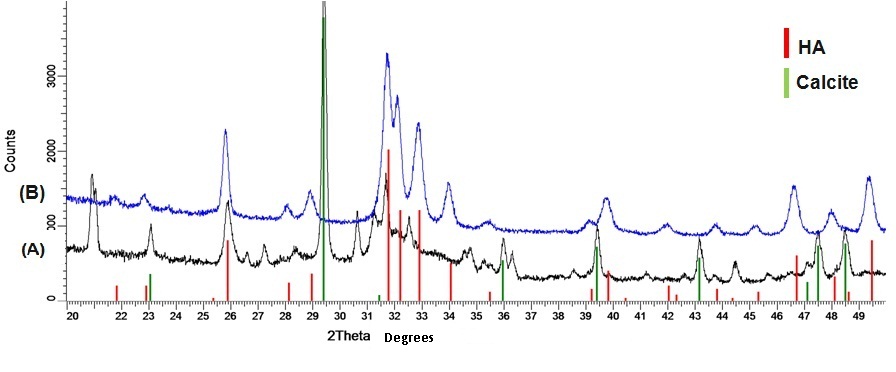New Generation of Hydroxyapatite Bone Grafts from ‘Coral like’ Synthetic Inorganic Precursors
-
1
Sree Chitra Tirunal Institute for Medical Sciences and Technology, Bioceramics Laboratory, India
Introduction: Hydroxyapatite being the inorganic component of bone tissue is the most studied biomaterial for use as bone grafts, scaffolds, fillers, cements, coatings etc for the repair and regeneration of bone defects [1]. Synthetic bone grafts overcome the problems of donor site morbidity and immune rejections. In the present scenario bone grafting is not only the replacement or regeneration of diseased or damaged tissue, but also the stimulatation of the process of bone remodelling by generating surface active moieties or cell signalling process possibly based on self-assembling, biomimetic, or nanofabrication methods [2]. Designing of bone grafts and scaffolds with the required interconnected porosity and adequate strength is a prerequisite for a tissue engineering scaffold. This helps in favouring osteogenesis, vascularisation, proper oxygenation and leads towards ossification [3],[4]. In the present study hydroxyapatite bone grafts/substitutes were synthesized from synthetic inorganic calcite and aragonite precursors via hydrothermal routes which involve the growth of exotic and unique crystal clusters with a preferred orientation in c-axis mimicking biological apatites under ambient conditions.
Materials and Methods: Porous precursors of calcium carbonate were made in different forms such as beads, blocks and pellets to form natural ‘coral like’ materials by using a setting solution of sodium hydroxide and phosphoric acid maintaining the pH around 4. These preforms were then hydrothermally converted to hydroxyapatite by exchange reactions in various phosphate solutions controlling the kinetic and thermodynamic parameters, retaining the strength and stability of the material. In vitro bioactivity was evaluated by cell adhesion and proliferation studies on the material for 14 days.
Results and Discussion: Phase identification by X-Ray Diffraction (XRD) shows that the initial precursor composition consists of calcite or aragonite phases. Further on hydrothermal conversion, progressive growth of the apatite phase was observed with time (1, 6, 12 hours). Microstructural analysis by Environmental Scanning Electron Microscopy (ESEM) shows that the newly developed material composed of clusters of apatitic crystals in plate like morphology with nacre like microstructure having porosities in the range of 20-500 microns. FTIR studies confirmed that the apatite is carbonated in nature. Excellent cell growth was observed in the material during 14 days of study which was analysed by cell titer blue assay.

Fig: 1 XRD pattern showing the conversion of Calcium carbonate (calcite) precursor to hydroxyapatite phase

Fig: 2 Microstructure of the scaffolds before (A) and after the exchange reactions (B-1h, C-6h, D-12 h)

Fig: 3 Cell proliferation study using cell titer blue assay.
Conclusion: Synthetic bioceramics are having low resorption properties mainly due to high temperature sintering processes used. Avoiding the high temperature sintering will improve the resorption property of the material by restricting the grain growth and thereby improving the dissolution of the material. Heavy metal contamination and low availability in harvesting environmentally concerned natural corals limits its usage as a precursor material. This study paves a novel method towards the development of new generation bioceramic scaffolds having adequate strength, large size, resorption and remodelling characteristics. The developed materials can be used for augmentation and reconstruction of dental and bone defects.
Director, Sree Chitra Tirunal Institute for Medical Sciences and Technology, Trivandrum, Kerala, India
References:
[1] Vaccaro, A.R., The role of the osteoconductive scaffold in synthetic bone graft. Orthopedics, 2002. 25(5 Suppl): p. s571-8.
[2] Hing, K.A., et al., Mediation of bone ingrowth in porous hydroxyapatite bone graft substitutes. J Biomed Mater Res A, 2004. 68(1): p. 187-200.
[3] Lee, K.Y., et al., Ceramic bioactivity: progresses, challenges and perspectives. Biomed Mater, 2006. 1(2): p. R31-7.
[4] Dorozhkin, S.V., Calcium orthophosphate-based biocomposites and hybrid biomaterials. Journal of Materials Science, 2009. 44(9): p. 2343-2387.
Keywords:
Bone Regeneration,
Cell Proliferation,
biomaterial,
Calcium phosphate
Conference:
10th World Biomaterials Congress, Montréal, Canada, 17 May - 22 May, 2016.
Presentation Type:
Poster
Topic:
Ceramics
Citation:
Mohan
N and
Varma
HP
(2016). New Generation of Hydroxyapatite Bone Grafts from ‘Coral like’ Synthetic Inorganic Precursors.
Front. Bioeng. Biotechnol.
Conference Abstract:
10th World Biomaterials Congress.
doi: 10.3389/conf.FBIOE.2016.01.00682
Copyright:
The abstracts in this collection have not been subject to any Frontiers peer review or checks, and are not endorsed by Frontiers.
They are made available through the Frontiers publishing platform as a service to conference organizers and presenters.
The copyright in the individual abstracts is owned by the author of each abstract or his/her employer unless otherwise stated.
Each abstract, as well as the collection of abstracts, are published under a Creative Commons CC-BY 4.0 (attribution) licence (https://creativecommons.org/licenses/by/4.0/) and may thus be reproduced, translated, adapted and be the subject of derivative works provided the authors and Frontiers are attributed.
For Frontiers’ terms and conditions please see https://www.frontiersin.org/legal/terms-and-conditions.
Received:
27 Mar 2016;
Published Online:
30 Mar 2016.